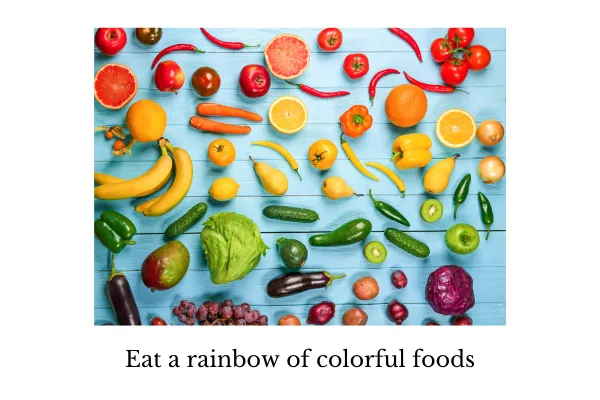
Eating the Rainbow
Eating the Rainbow: A Guide to Nutrient Diversity
“Eating the rainbow” is more than just a fun phrase—it’s a simple and powerful way to support your health. This approach encourages eating a variety of colorful fruits and vegetables each day. Different colors mean different nutrients, and together they give your body what it needs to feel strong, energized, and protected from disease.
Dr. Deanna Minich, a nutrition scientist and creator of the Rainbow Diet, explains that colorful plant foods contain special compounds called phytonutrients. These compounds help reduce inflammation, protect cells, and promote healing throughout the body.¹
In this article, we’ll break down the science behind eating the rainbow and show you easy ways to add more color to your meals.
Why Is Eating the Rainbow Important?
Plants contain phytonutrients—natural compounds that give fruits and vegetables their vibrant colors. Each color signals a different set of nutrients and benefits for your health. When you eat a wide range of colors, you give your body a mix of antioxidants, fiber, vitamins, and minerals it needs to stay balanced and strong.²
Key Benefits of Eating the Rainbow
More Nutrients: Each color offers different vitamins, minerals, and plant compounds.
Cell Protection: Antioxidants protect your cells from damage and aging.
Lower Disease Risk: A colorful diet helps prevent heart disease, diabetes, and certain cancers.³
Better Gut Health: Fruits and vegetables are high in fiber, which supports a healthy microbiome.⁴
Reference:
Slavin JL, Lloyd B. (2012). Adv Nutr.
Breaking Down the Colors of the Rainbow
🔴 Red Foods
Red foods are rich in lycopene and anthocyanins, which help reduce inflammation and protect the heart.
Examples: Tomatoes, red bell peppers, strawberries, watermelon, beets
Health Benefits:
Lycopene in tomatoes may reduce the risk of prostate cancer.⁵
Anthocyanins in strawberries help support heart health.
Reference:
Giovannucci E. (1999). J Natl Cancer Inst.
🟠🟡 Orange and Yellow Foods
These foods are high in beta-carotene and vitamin C. Beta-carotene turns into vitamin A in your body, which is important for eye health and immunity.
Examples: Carrots, sweet potatoes, mangoes, pineapple, yellow peppers
Health Benefits:
Beta-carotene supports healthy vision and skin.
Vitamin C boosts immune function and helps the body heal.
Reference:
Sies H, Stahl W. (2005). Am J Clin Nutr.
🟢 Green Foods
Green vegetables contain chlorophyll, lutein, folate, and glucosinolates, all of which support detoxification and cell repair.
Examples: Spinach, kale, broccoli, avocado, green apples
Health Benefits:
Lutein protects your eyes from age-related damage.
Sulforaphane (from broccoli) supports the liver’s detox pathways.⁶
Reference:
Fahey JW, et al. (1997). Phytochemistry.
🔵🟣 Blue and Purple Foods
These foods are high in anthocyanins and resveratrol, powerful antioxidants that protect your brain and heart.
Examples: Blueberries, blackberries, eggplant, purple cabbage, plums
Health Benefits:
Anthocyanins may help improve memory and brain health.⁷
Resveratrol supports cardiovascular function.
Reference:
Cassidy A, et al. (2013). Circulation.
⚪ White and Brown Foods
Even though they’re not colorful, white and brown fruits and vegetables still offer important health benefits. Many contain allicin and beta-glucans, which support the immune system.
Examples: Garlic, onions, cauliflower, mushrooms, bananas
Health Benefits:
Allicin in garlic has antibacterial and antiviral effects.
Mushrooms contain compounds that boost immune response.⁸
Reference:
Shukla Y, Kalra N. (2007). Cancer Lett.
Practical Tips for Eating the Rainbow
Add Color to Every Meal:
Try to include at least 3–4 colors on your plate.
Example: A salad with spinach, shredded carrots, cherry tomatoes, purple cabbage, and avocado.Choose Seasonal Produce:
Seasonal fruits and vegetables are fresher, tastier, and often more affordable.Blend or Juice for Convenience:
Smoothies are an easy way to combine different fruits and veggies.
Example: Kale + mango + banana + blueberries = nutrient-packed smoothie.Plan Ahead:
Stock your kitchen with colorful produce, and prep ingredients in advance to make healthy eating easier.Make It Fun:
Challenge your family to eat all the colors in one week—or even one day!
Eating the Rainbow and Chronic Disease Prevention
Many studies show that eating a variety of fruits and vegetables helps lower the risk of serious health conditions. A colorful, plant-rich diet supports long-term health and disease prevention.⁹
Diseases Linked to Low Fruit & Veg Intake:
Heart Disease: Antioxidants reduce oxidative stress and inflammation.
Diabetes: Fiber-rich foods help manage blood sugar levels.
Cancer: Phytochemicals like sulforaphane and anthocyanins may protect against cancer cell growth.
Reference:
Boeing H, et al. (2012). Eur J Epidemiol.
Conclusion
Eating the rainbow is one of the easiest and most enjoyable ways to improve your health. Each color gives your body something unique. By filling your plate with a variety of fruits and vegetables every day, you support your body’s natural ability to heal, thrive, and prevent disease.
Start small: add one new color to your plate today. Over time, those small changes add up to a big difference in how you feel.
Your body—and your future self—will thank you.
Complete List of References
Deanna Minich, PhD. https://deannaminich.com/
Slavin JL, Lloyd B. (2012). Health benefits of fruits and vegetables. Adv Nutr.
Boeing H, et al. (2012). Fruit and vegetable consumption and mortality from all causes. Eur J Epidemiol.
Wang X, et al. (2014). Fruit and vegetable consumption and risk of type 2 diabetes. BMJ.
Giovannucci E. (1999). Lycopene and cancer. J Natl Cancer Inst.
Fahey JW, et al. (1997). Glucosinolates in plants. Phytochemistry.
Cassidy A, et al. (2013). Anthocyanins and cardiovascular health. Circulation.
Shukla Y, Kalra N. (2007). Garlic in cancer prevention. Cancer Lett.
Aune D, et al. (2017). Fruit and vegetable intake and health outcomes. Int J Epidemiol.
